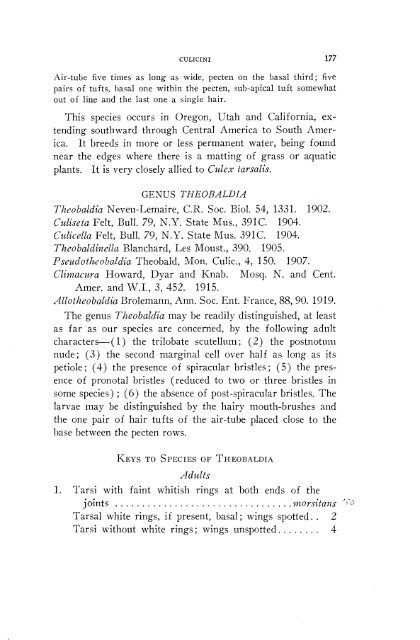a handbook of the mosquitoes of north america - Systematic Catalog ...
a handbook of the mosquitoes of north america - Systematic Catalog ...
a handbook of the mosquitoes of north america - Systematic Catalog ...
You also want an ePaper? Increase the reach of your titles
YUMPU automatically turns print PDFs into web optimized ePapers that Google loves.
CULICINI 177<br />
Air-tube five times as long as wide, pecten on <strong>the</strong> basal third; five<br />
pairs <strong>of</strong> tufts, basal one within <strong>the</strong> pecten, sub-apical tuft somewhat<br />
out <strong>of</strong> line and <strong>the</strong> last one a single hair.<br />
This species occurs in Oregon, Utah and California, ex-<br />
tending southward through Central America to South Amer-<br />
ica. It breeds in more or less permanent water, being found<br />
near <strong>the</strong> edges where <strong>the</strong>re is a matting <strong>of</strong> grass or aquatic<br />
plants. It is very closely allied to Czllex tarsalis.<br />
GENUS THEOBALDIA<br />
Theobaldia Neveu-Lemaire, C.R. Sot. Biol. 54, 1331. 1902.<br />
CuZisetal Felt, Bull. 79, N.Y. State Mus., 391C. 1904.<br />
CuZiceZZa Felt, Bull. 79, N.Y. State Mus. 391C. 1904.<br />
Theobaldinella Blanchard, Les Moust., 390. 1905.<br />
Pseudo<strong>the</strong>obaldia Theobald, Mon. Culic., 4, 150. 1907.<br />
CZkacz/lra Howard, Dyar and Knab. Mosq. N. and Cent.<br />
Amer. and W.I., 3, 452. 1915.<br />
ACCo<strong>the</strong>obalZdia Brolemann, Ann. Sot. Ent. France, 88,90. 1919.<br />
The genus TheobaZdia may be readily distinguished, at least<br />
as far as our species are concerned, by <strong>the</strong> following adult<br />
characters -( 1) <strong>the</strong> trilobate scutellum; (2) <strong>the</strong> postnotum<br />
nude; (3) <strong>the</strong> second marginal cell over half as long as its<br />
petiole ; (4) <strong>the</strong> presence <strong>of</strong> spiracular bristles ; (5) <strong>the</strong> pres-<br />
ence <strong>of</strong> pronotal bristles (reduced to two or three bristles in<br />
some species) ; (6) <strong>the</strong> absence <strong>of</strong> post-spiracular bristles,. The<br />
larvae may be distinguished by <strong>the</strong> hairy mouth-brushes and<br />
<strong>the</strong> one pair <strong>of</strong> hair tufts <strong>of</strong> <strong>the</strong> air-tube placed close to <strong>the</strong><br />
base between <strong>the</strong> pecten rows.<br />
KEYS TO SPECIES OF THEOBALDIA<br />
Adults<br />
1. Tarsi with faint whitish rings at both ends <strong>of</strong> <strong>the</strong><br />
joints . . . . . . . . . . . . . . . . . . . . . . . . . . . . . . . . . morsitam ‘;‘a<br />
Tarsal white rings, if present, basal; wings spotted. . 2<br />
Tarsi without white rings; wings unspotted. . . . . . . . 4

















